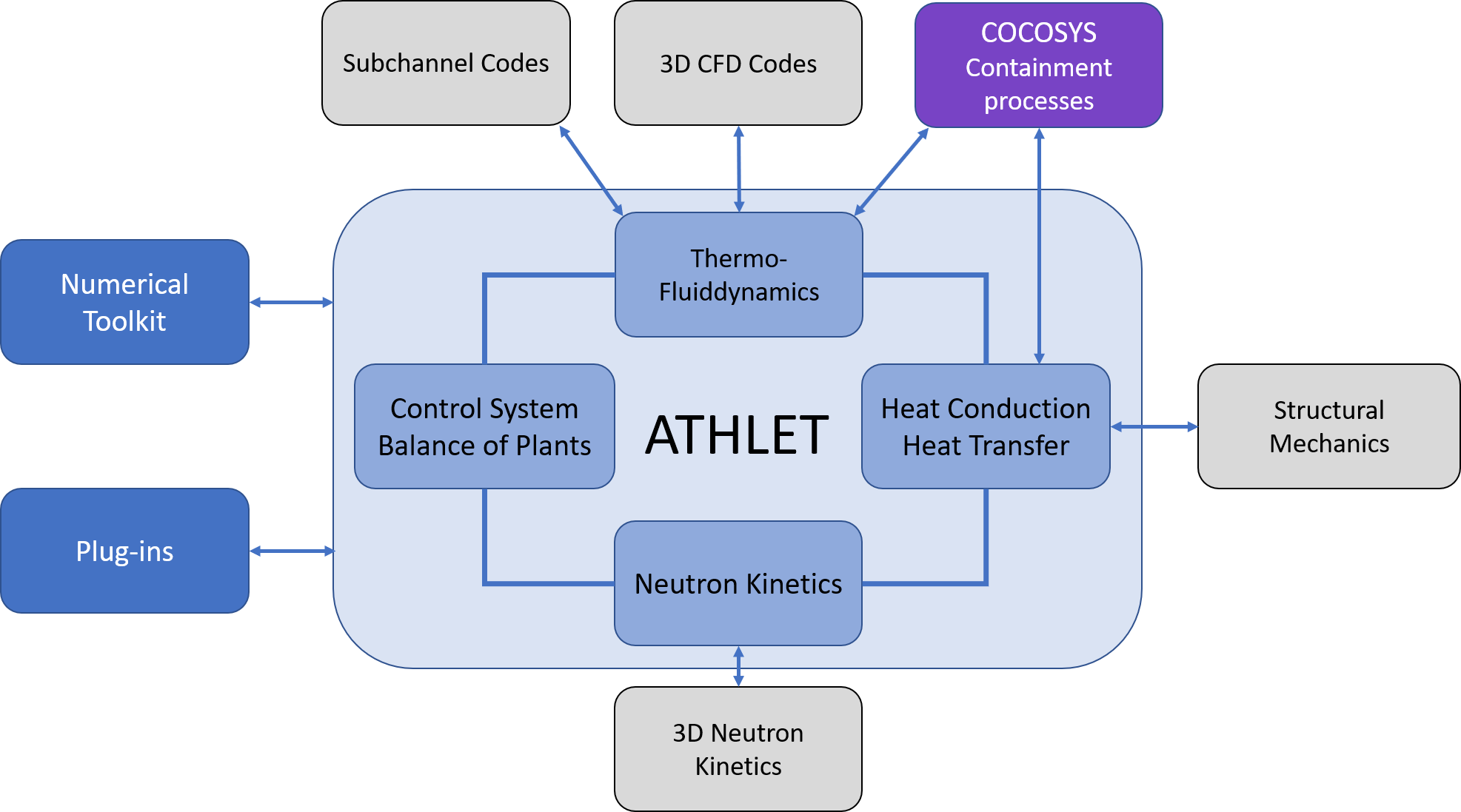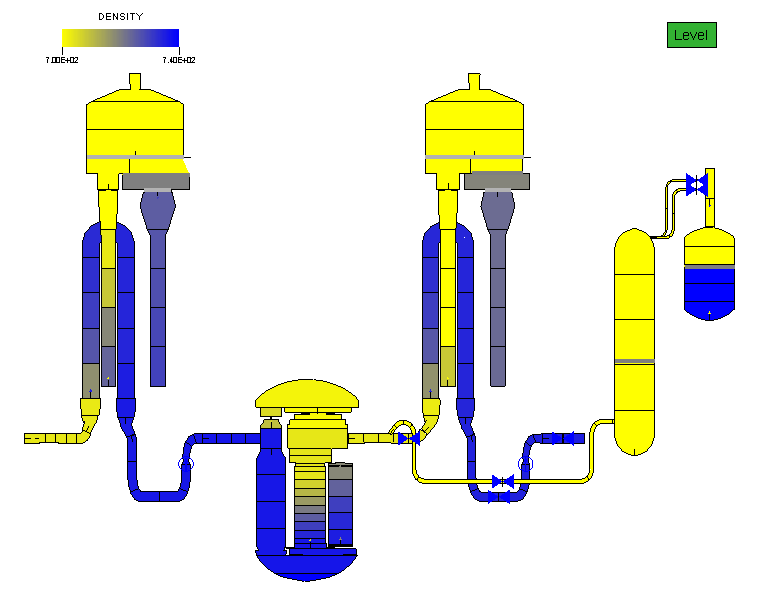ATHLET program overview
The thermal-hydraulic system code ATHLET (Analysis of THermal-hydraulics of LEaks and Transients) is developed by GRS for the analysis of the whole spectrum of operational conditions, incidental transients, design-basis accidents and beyond design-basis accidents without core damage anticipated for nuclear energy facilities. The code provides specific models and methods for the simulation of many types of nuclear power plants comprising current light water reactors (PWR, BWR, VVER, RBMK), advanced Generation III+ and IV reactors as well as Small Modular Reactors. The latest code release version is ATHLET 3.4, which is included in the code package AC² 2023. AC² is available for both Windows and Linux operating systems.
A brief code description is provided by the ATHLET Overview.
The essential features of ATHLET are advanced thermal-hydraulic modelling ensuring the code’s versatile applicability, modular program architecture with separation of physical models and numerical methods and a flexible interface concept for external code coupling and user-provided model extensions. In addition, interactive simulation control and visualization is enabled by the GRS analysis simulator ATLAS and its successor ATLASneo.
| ATHLET is composed of several basic modules for the simulation of the fundamental, multiphysical phenomena involved in the operation of a nuclear reactor, including thermo-fluid dynamics, heat conduction and heat transfer, neutron kinetics as well as control and balance-of-plant, supplemented by an implicit numerical time integration method. Other independent modules such as 3D neutron kinetic codes, Computational Fluid Dynamics (CFD) codes or the GRS containment simulator COCOSYS can be coupled by means of suitable interfaces. For the analysis of beyond design-basis accidents with core degradation, the extended code ATHLET-CD is applicable. | 
|
Thermalhydraulics
The thermal fluid dynamic model of ATHLET is based on a six-equation two fluid model with fully separated balance equations for liquid and vapor. Alternatively, a five equation model with a mixture momentum equation and a full-range drift-flux formulation for the calculation of the relative velocity between the phases is available. In order to improve the simulation of complex, multidimensional flow behaviour, the underlying one-dimensional modelling has been extended by a fully three-dimensional set of balance equations. The range of working fluids covers light and heavy water with consideration of the transition between subcritical and supercritical fluid states. In addition, helium, liquid sodium, potassium, lead and LBE (Lead-Bismuth Eutectic) can be selected as coolant. Depending on the selected working fluid, dedicated models for the simulation of non-condensable gases, of dissolved nitrogen, and of boron or zinc-borate transport are also provided. Approved correlations are employed for the calculation of the one- and two-phase heat transfer in the reactor core, in heat exchangers and at walls.
Validation
The code’s quality and capability is ensured by a continuous and systematic validation process that is based on a well-balanced set of integral and separate effect tests derived from the OECD/NEA/CSNI code validation matrices. In the frame of numerous national and international projects, benchmarks and International Standard Problems, ATHLET was successfully employed for pre-test and post-test calculations of both small and large scale experiments, e.g. from the test facilities UPTF, PKL and LSTF. With regard to passive safety systems, experimental data e.g. from ATLAS and INKA facilities were used to investigate the code's capability. For future Generation IV reactor designs and Accelerator-Driven Subcritical systems, the code’s validation is underway against experimental data e.g. from TALL, KASOLA and MYHRRA test facilities.
Current Applications
ATHLET is internationally applied by technical safety organizations, regulatory authorities, research institutions and operating companies from more than 20 countries worldwide. Current applications are related to the simulation of e.g. passive safety systems of various reactor designs, the cooling of fuel assembly storage tanks, research reactors, and SMR. Moreover, new system components and working fluids of future reactor designs are investigated. Additionally, ATHLET has been used for e.g. analyses concerning the increase of power and enrichment, core damage analyses, reactivity initiated events, periodic safety analyses, and probabilistic safety analyses. Beyond nuclear reactor applications, ATHLET has been employed for analyses related to conventional power plants and solar energy systems.
Release Versions
A history of code versions is given below. Please follow the links for a listing of new features and major model improvements.
- ATHLET 3.4 (released in Dec. 2023): ATHLET 3.4 Program Updates and NuT 2.0.2 Updates
- ATHLET 3.3 (released in Nov. 2021) and NuT 2.0: ATHLET 3.3 Updates and NuT 2.0 Updates
- ATHLET 3.2 (June 2019): ATHLET Updates 3.1A-3.2
- ATHLET 3.1A (May 2016): Updates 3.0A-3.1A
- ATHLET 3.0A (Jan. 2013): Updates 2.2A-3.0A
- ATHLET 2.2A (Sept. 2009): Updates 2.1A-2.2A
- ATHLET 2.1A (Aug. 2006)
- ATHLET 2.0A (Nov. 2003)
- ATHLET 1.2A (May 1998)
- ATHLET 1.1A (March 1993)
- ATHLET 1.0A (Sept. 1988)

